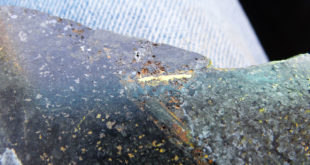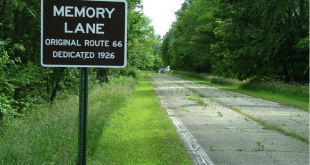“Now they are talking about this new currency the argentino. You might as well take a newspaper and cut it up into little pieces of paper and call that money.”
– Susana Diegas, Buenos Aires housewife, about the stillborn Argentinian currency – the Argentino.
Predictions for 2002
It’s traditional to make predictions at the start of the New Year. Now it’s my turn, so let me make my prediction for 2002. This year, somewhere, someone will make a new mineral discovery that will set the investment and exploration world on fire. I don’t know where it will be. I don’t know by whom. I don’t know if it will be gold, silver, platinum, or diamonds, but it will happen, because it has always happened before. We’ll see some company go from say 25 cents to 60, then a dollar, then two, then five, by which time the analysts and the columnists will be talking about it. Also, by this time a myriad of other juniors will be staking land positions as close in as possible to the discovery. In a week or two, you won’t be “anyone” unless you’ve got a land position in the play. A feeding frenzy. This is how it will unfold. This is how it always unfolds. And, if the play carries on for long enough, someone else, someplace else in the world will also make a great discovery, and ALL junior miners will start moving, as they did in 1995 and ‘96, after Pierina and the bogus Bre-X. The last boom was the first truly global boom, as barriers to foreign investment fell in many countries, and doors were opened to the former Soviet Union. At the time I found myself running a project in Kazahkstan, where a few years before it would have been unthinkable. The rationale for investment was “the more remote the better”, because that was “elephant country” – where the huge deposits waited to be found.
We have seen some spectacular frenzy-type investor binges in latter times. Remember Lac de Gras in ‘90, Eskay Creek in ‘88 and Hemlo in ‘81? Australia and Papua New Guinea had a rash of rich discoveries by juniors in the mid to late 1980’s which eventually lured me to Queensland for a year in ‘88. If one were to look at history, we see that the record of discovery is not continuous. Some huge speculative plays were the Cobalt in 1903-06, Tonopah-Goldfield in 1905-06, the Klondike in 1896-98, White Water Ridge on the Rand in 1886, Kimberley in 1869-72, the Comstock Lode in 1859, Ballarat in 1851, and the California Mother Lode in 1848-49. All of these plays were rooted in bonafide very rich discoveries, which each spawned hundreds, even thousands of proximity plays by small companies. Mineral exploration is cyclical due to macroeconomic factors – but it should also be recognized that investment opportunity in new mining camps has a beginning, a middle, and usually a trailing-off end. This is because, as exploration progresses there will logically always be more losers than winners. After the initial euphoria swirling around the early fantastic results, further exploration will disprove various neighbouring prospects. With time, a shrinking number will remain promising, and maybe only one or two will eventually prove viable. By the time the feasibility study rolls around on the one or two mineable deposits, usually the opportunity to make great investment profits is gone. The cycle from boom to bust can be months or years, depending on how long it takes for exploration results to come out. And then as the saying goes, “Buy on mystery, sell on history”.
Exploration plays never exist in a vacuum. There has to be a market, and available investment money for things to take off, otherwise prospectors toiling in the bush can’t find backers and juniors either go out of business or into cocoon mode. Before the rise of the tech sector and dotcoms, historically it was only mineral exploration which offered the opportunity to (sometimes) quickly double, treble or quadruple your investment. Obviously, it is always a possibility for explorers to suddenly find great wealth. This is what has driven prospectors into the hinterland for thousands of years and has sustained stock market plays in mining for over 200 years. But mineral exploration has traditionally only captured the attention of a small proportion of investors. Today, the first time investor who jumped into the equity markets in 1999-2000 is looking for the same fat returns he got from tech.
The boom times are a comin’. When it happens, everyone who has been saying for months that only producers are good, that only companies with income are good, that only companies that have profits and pay dividends are good, and that only companies with projects in USA or Canada are good – all of it will go by the wayside. All it takes is one junior to get lucky, the stage is already set.
January 22nd-25th we’ll be taking the pulse of the industry (yes, there still is one) at the Cordilleran Roundup in Vancouver, which is a meeting sponsored by the British Columbia and Yukon Chamber of Mines. We’ve been there before, but according to their website, this year there will be over 2000 delegates and 200 mining and supply companies represented. Before the geological stuff gets started, on January 20th-21st there’ll be a free investment conference. STRAIGHT TALK will be there, and we’ll be reporting on the investment conference as well as the geological conference. March 10th-13th will be the Prospector and Developers Convention in Toronto, the world’s biggest mining convention. We’ll be there too. We’ve been thinking of taking in the Indaba Conference in Cape Town, on February 12th-14th but it’s very pricey and we reckon only a handful of top execs will show.
There is a palpable change in the air. As widely reported, Goldcorp is now holding back gold sales and waiting for higher prices. Iamgold has bought 0.7 tonnes with their discretionary funds and is offering to pay investors dividends in bullion. Now that’s a vote of confidence in the gold price! With interest rates so low, why keep your proceeds from gold sales in dollars? Why sell gold at all if you don’t have too? What’s the downside for gold? Now, what’s the upside?? Talk about a no-brainer!
During the run up to the tech wreck I talked with many junior exploration companies. We all know that many didn’t survive the aftermath of the Bre-X crash. The venture capital that normally would have gone into junior mining penny stocks was sucked out, and sunk into speculative tech, dot.coms and biotech – all the darlings of the New Era. A huge explosion of twentysomething analysts with newly-minted MBA’s entered the scene – none of whom knew or cared the slightest bit about mining or mineral exploration. Mining? Bah, humbug. A has-been. A finished-for-good industry. Most of these guys are now the discarded flotsam and jetsam of the New Era and are pounding the pavement looking for work. Merrill is the latest company to rid itself of these useless drones.
Why will the boom happen?
We see evidence of systemic risk in the economy every which way you turn. The American consumer is maxed out. His interest-free loan on a new Ford was a great idea, but he can’t pay back the principal. Xmas 2001 was on credit. He still owes for Xmas 2000, and probably Xmas 1999 too. Rampant consumerism is done. It is a spent force. In other words, the future for most equities looks bleak. Those who live in cooler climates know how much dirt, trash and dog poop is exposed every spring when the snow melts away. The Bubble was like a thick white blanket of snow, that hid unpleasant reality. The former blue chip, Enron suddenly went Bang! And now there’s talk of collusion between rating agencies, investment managers, bankers, accounting firms, senior executives and government. Today we heard on television: “This can happen in many other American corporations”. (Arthur Levitt, Former Chairman, Securities and Exchange Commission, ABC NEWS This Week). How many other Enrons are lurking out there? What’s propping up the dollar? What to invest in now?
For a couple of years now we’ve known that the gold and silver carry trade has been flooding the market with precious metals. It now looks like the supply, at least for silver, is drying up. Ted Butler thinks she’s all done – that all the silver that could be lent has been lent – and sold – into the market, hence the steep lease rates we’re seeing now. It was always a finite game – gold and silver demand has outstripped new mine supply for years. Eventually the stocks would be drawn down and only increased prices would induce investors to dishoard. We’ve heard all the stories by the conspiracy theorists that the prices of the metals are being depressed by concerted dumping. Does this all sound too far fetched now after the Enron debacle?
The situation is so precarious right now, all it would take to move gold would be for the Chinese or the Japanese to liquidate some dollar holdings and send the buck into a tailspin. Wouldn’t matter if they bought gold, Euros, Swiss Francs or Kazahk Tenge. If the safe-haven status of the dollar goes by the board, gold will shoot to the stratosphere.
The stars are aligned like never before for higher gold and silver prices.
How will the next mining boom differ from those before?
The Internet, and “Investing as Entertainment”. We saw a ton of talking heads saying a few weeks ago:
recession historic average in months = x
present recession length to date in months = y
because x – y = z, we have z months left to go.
Another reason to boost the markets! If any of these nitwits had taken symbolic logic or even had a lick of common sense, they would have seen the obvious flaw in extrapolating past market behaviour to the present. Do you remember the LTCM collapse? (Read “When Genius Failed; The Rise and Fall of Long-Term Capital Management” by Roger Lowenstein.). An unexpected event – the Russian default – was the undoing of LTCM. Now we have a double whammy – Argentina and Enron.
It is a Brave New World. On T.V. everyday is a Brand New Day. Never underestimate the power of the media. They have sustained the Bubble better and for longer than anyone could at any other time in history, but like Adam Hamilton says in his latest commentary – “Show me the money!” They can’t, and now the talking heads have lost their credibility. Better just to collapse the tent and move on to something else. This is why the fickle media which mostly up to now has taken cheap shots at precious metals will get on board. Precious metals are going to be the only game in town. Now, what is different in 2002 compared to the past, that practically no one focuses on is the spectacular growth in investment publications, television investment programming, and the internet. There are now entire networks devoted to investments. Ten years ago there was no such thing as day trading, or internet chatrooms, or on-line investment forums. What would happen if La Pierina, Barrick’s flagship mine, which was found by Vancouver junior Arequipa Resources were found today by a penny junior? With “investing as entertainment” and the explosive growth of the internet; with the market still not the slightest bit interested in “staying the course” and “investing for the long term”; with instant gratification still very much the desire; we could see mining stocks shoot higher and faster than ever before.
We have seen some great discoveries in the last couple of years. Brancote Holdings of the UK in Argentina found the Esquel gold-silver deposit in 1998. Pacific Rim Mining Corp. discovered the Diablillos silver-gold deposit in Argentina (now sold to Silver Standard) and drilled it out in 1996-97. There have been some great drill holes pulled at Hope Bay, Nunavut by Miramar Mining. They purchased their deposit from BHP in 1999. Francisco Gold found the Marlin deposit, a large low sulphidation epithermal gold-silver deposit in Guatemala, in 1998. Gabriel Resources proved up the Rosia Montana gold project in Romania. It was known in Roman times but only drilled off in 1997.
All these companies have seen significant share price increases as a result of their discoveries, however nothing compared to what would have been in 1995-96. Since the gold price started to decline in the second half of 1996, and especially after Bre-X blew up in March, 1997, the investment world has largely ignored precious metals, and the news of these discoveries largely went into the void. No wonder, with the meteoric run up in prices of stocks like Nortel, Amazon, Lucent, or JDS Uniphase. Against the backdrop of increasing gold and silver prices, and bullish sentiment, we could see a radical change, and a new focus of the spotlight on precious metal exploration. The internet offers a means to disseminate information in a cheaper and more immediate, and targeted fashion than ever before. I say targeted, because those without computers are probably less likely to have the discretionary cash to invest. Internet chatrooms provide a wider forum for investments than ever before. I personally didn’t start using E-mail until 1996. Many people I know were signed up before myself, but by the time the internet really took off in popularity the last mining boom was finished – it could be argued one finished the other. We have yet to see a mining boom in these cyber times.
The spectre of Bre-X is quickly fading, but the court cases still go on. When the next mining boom hits – and it will – you owe it to yourself or to your clients to dig deep, get the facts, and become as knowledgeable as you can before you park your money. It’s going to be a great year.
 Straight Talk On Mining Insights on mining from economic geologist Dr. Keith Barron.
Straight Talk On Mining Insights on mining from economic geologist Dr. Keith Barron.




